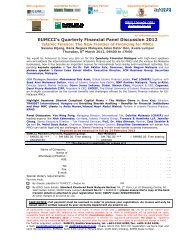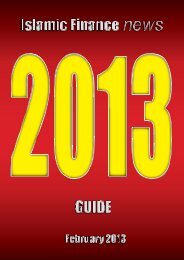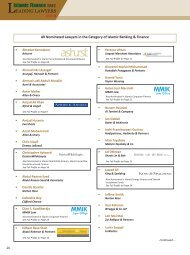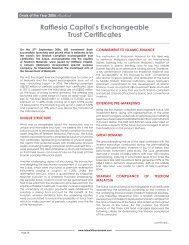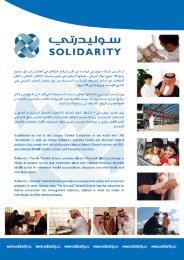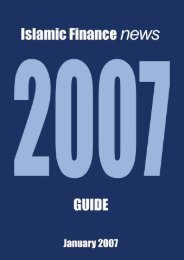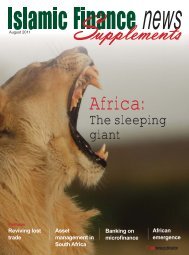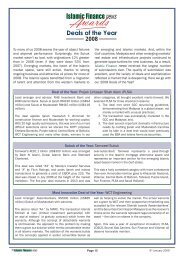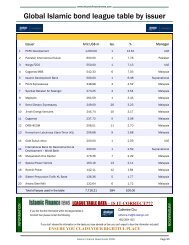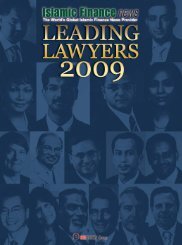Sample - Islamic Finance News
Sample - Islamic Finance News
Sample - Islamic Finance News
You also want an ePaper? Increase the reach of your titles
YUMPU automatically turns print PDFs into web optimized ePapers that Google loves.
<strong>Islamic</strong> <strong>Finance</strong> news Guide 2007<br />
<strong>Islamic</strong> Debt as the Global Propeller<br />
By Badlisyah Abdul Ghani and Shamsun A. Hussain<br />
<strong>Islamic</strong> debt is the real missing link in the <strong>Islamic</strong><br />
finance industry, as at present the global regulatory<br />
legal framework has designed debt to be interestbased.<br />
Differing regulatory and tax regimes, diverse legal frameworks<br />
and disparate banking rules all infl uence effective<br />
communication between <strong>Islamic</strong> fi nancial centers and<br />
market players on how to manage the business. Complying<br />
with Shariah is the easy part of the industry; sorting out<br />
the intricacies of undertaking the Shariah compliant nature<br />
of <strong>Islamic</strong> debt is a more interesting challenge. As a result,<br />
<strong>Islamic</strong> debt transactions are not as cost-effective as they<br />
should be in many jurisdictions. Institutions in Malaysia and<br />
the Middle East have been trying to bridge this gap, and 2006<br />
saw the largest number of <strong>Islamic</strong> debt transactions brought<br />
to the market thus far.<br />
Some of the activity that has been seen in the market includes<br />
Malaysia’s tax neutrality announcement in 2004, which has<br />
proven how critical the tax issue is to the development of<br />
the industry. After this announcement, the market share of<br />
<strong>Islamic</strong> debt securities shot up to more than 70% of Malaysia’s<br />
total corporate bonds issuance. Singapore, a budding <strong>Islamic</strong><br />
fi nance jurisdiction, also announced some tax neutrality when<br />
the country entered the industry. Many other jurisdictions have<br />
made similar proactive moves, including the UK, the US state<br />
of New York and Queensland in Australia. Tax neutrality allows<br />
<strong>Islamic</strong> banking products or debt securities to be treated in<br />
the same manner as their conventional counterparts. No<br />
extra tax or stamp duties will be imposed. Equity instrument<br />
contracts, whether conventional or <strong>Islamic</strong>, are similar. As a<br />
result, the development of <strong>Islamic</strong> equity is a lot simpler.<br />
The success of the <strong>Islamic</strong> debt market will have a direct<br />
impact on the developmental success of the <strong>Islamic</strong> fi nance<br />
industry. Thus all <strong>Islamic</strong> fi nance players, including <strong>Islamic</strong><br />
bankers, Shariah advisors or Shariah committee members,<br />
regulators and other key industry players must pay extra<br />
attention to issues other than Shariah, particularly tax, legal<br />
and regulatory frameworks, which will become a tipping point<br />
to the development of <strong>Islamic</strong> fi nance industry globally.<br />
Background<br />
A successful fi nancial market requires all industry components<br />
to be present – debt market, equity market, banking industry,<br />
non-banking sectors (e.g. trusts, waqf, etc...), baitulmal and<br />
zakat. Some people argue that <strong>Islamic</strong> fi nance is all about<br />
equity instruments, not about debt instruments. Nevertheless,<br />
the same people will also agree that activities such as<br />
Murabahah sale (where the price is paid in the future) and<br />
Ijarah (where the purchase undertaking is in the future) are<br />
also Shariah compliant fi nancial instruments. The <strong>Islamic</strong><br />
fi nance industry will never be relevant and signifi cant to the<br />
national economic agenda of a particular jurisdiction until all<br />
components of the industry are developed.<br />
This article attempts to address the complexities in dealing<br />
with the challenging status of <strong>Islamic</strong> debt to be developed as<br />
a key component of a nation’s <strong>Islamic</strong> fi nance industry and<br />
the fi nancial market as a whole, operating on a par with, and<br />
being as convenient as, the conventional debt market. In this<br />
article, for the purpose of clarity, <strong>Islamic</strong> debt is defi ned to<br />
include all banking products, as well as <strong>Islamic</strong> fi xed-income<br />
securities products.<br />
<strong>Islamic</strong> debt?<br />
“Debt” has always been interpreted to be loans with riba<br />
(interest), which makes any discussion on <strong>Islamic</strong> debt sound<br />
very odd indeed. All fi nance students and bankers have been<br />
trained in debt transactions based on riba.<br />
Conventional debt is a fi nancial obligation arising from<br />
borrowed monies that a customer takes from a fi nancier/<br />
investor, while <strong>Islamic</strong> debt is a fi nancial obligation arising<br />
from a plethora of trade relationships entered into between<br />
a fi nancier/investor and a customer/issuer. Many Shariah<br />
principles can be used for this trade relationship, such as<br />
Murabahah (installment sale), Bai Bithaman Ajil (deferred<br />
payment sale), Ijarah (lease/hire), Mudarabah (partnership),<br />
Musharakah (joint venture), Inah (buy and sell transactions),<br />
Salam (forward sale), Istisnah (sale by order), etc... A loan can<br />
also take place under the Shariah principle of Qard – the only<br />
loan permissible under Shariah because it is interest free.<br />
Why is the <strong>Islamic</strong> debt market important?<br />
To determine how important the <strong>Islamic</strong> debt market is to the<br />
well-being and growth of the <strong>Islamic</strong> fi nancial market, we must<br />
look at the composition of a successful and sound fi nancial<br />
market. The debt securities market in developed countries<br />
such as the US or the UK is mature and is widely used as<br />
a means of fundraising. In the US, 72% of its fundraising<br />
is done via the debt capital market, which is worth about<br />
US$23.84 trillion, as compared to bank loans of US$9.34<br />
trillion in 2005.<br />
For emerging market countries, particularly Asia (excluding<br />
Japan) there was a 27% market share in 2005, which<br />
increased from 24% in 2004. On the other hand, in the<br />
continued...<br />
www.islamicfinancenews.com
<strong>Islamic</strong> <strong>Finance</strong> news Guide 2007<br />
<strong>Islamic</strong> Debt as the Global Propeller (continued...)<br />
Middle East, supposedly the home of <strong>Islamic</strong> banking, there<br />
was a mere 7% of total fundraising in the form of debt in<br />
2005. Banking assets still dominate the Asian and Middle<br />
Eastern markets. In order to have a sound fi nancial market,<br />
both these markets need to develop their debt capital market<br />
including their <strong>Islamic</strong> debt capital market.<br />
Issuers will be more likely to tap the debt capital market to<br />
raise funding for projects and assets acquisition. Investors<br />
needs are becoming more sophisticated and they are<br />
demanding more debt securities products.<br />
A debt transaction is not necessarily a loan<br />
transaction!<br />
An <strong>Islamic</strong> debt transaction may be entered into to meet<br />
various requirements, arising from personal, business or<br />
societal needs. When someone plans to buy a home, a need<br />
to own a house is identifi ed. A mature <strong>Islamic</strong> fi nancial market<br />
should be able to facilitate this need effectively by providing<br />
an <strong>Islamic</strong> debt facility from an <strong>Islamic</strong> bank by way of a loan<br />
or by way of trade. Whether it is an equity participation or an<br />
interest-free loan or a trade, the <strong>Islamic</strong> bank’s only purpose<br />
for undertaking the transaction is to facilitate the home<br />
buyer’s needs. A debt transaction is not tantamount to an<br />
interest-bearing loan.<br />
<strong>Islamic</strong> debt is critical to business and economy<br />
Project fi nance, corporate fi nance and asset fi nance are all<br />
key business needs, and an <strong>Islamic</strong> banking practitioner must<br />
understand these key needs and understand how to optimally<br />
meet them. The optimum level objective plays a signifi cant<br />
role in appreciating and understanding the applicability of<br />
<strong>Islamic</strong> debt transactions for a project or an investment.<br />
Below is an illustration:<br />
Here, project fi nance is being contemplated. What would<br />
be the optimum fi nancing model as far as debt to equity<br />
Diagram 1: Regional debt securities vs bank assets<br />
Regional Banking Assets vs Debt Securities<br />
requires? First of all, the key consideration is meeting and<br />
matching the needs and objectives of equity investors and<br />
the needs and objectives of debt investors. Generally, equity<br />
investors are driven by return on equity (ROE). Certainty of<br />
ROE will be subject to performance of the project at residual<br />
level as it ranks junior to debt investors. At the same level of<br />
project Internal Rate of Return (IRR), ROE will be able to earn<br />
different return levels depending on composition of debt. At<br />
the same level of project IRR, the higher the debt level, the<br />
higher ROE is expected and vice versa. Any upside return on<br />
the project will go straight to equity investors. Thus, equity<br />
investors would be looking forward to have the lowest equity<br />
contribution to a project and have the highest portion possible<br />
on debt fi nancing part.<br />
Three cases below demonstrate the above scenarios:<br />
Case A<br />
Project Cost 100<br />
Debt 90<br />
Equity 10<br />
Profi t before Debt cost 15<br />
Debt cost (i.e. ijarah rate - 10%) 9<br />
Net Profi t after Debt Cost 15-9 = 6<br />
Based on the above, ROE to equity investors is 60% (based<br />
on 6/10)<br />
Case B<br />
Project Cost 100<br />
Debt 50<br />
Equity 50<br />
Profi t before Debt cost 15<br />
Debt cost (i.e. ijarah rate - 10%) 5<br />
Net Profi t after Debt Cost 15-5 = 10<br />
Based on the above, ROE to equity investors is 20% (based<br />
on 10/50)<br />
continued...<br />
Regional Banking Assets vs Debt Securities<br />
Indonesia<br />
6.90<br />
155.45<br />
Indonesia<br />
6.92<br />
134.00<br />
Malaysia<br />
109.00<br />
252.50<br />
Malaysia<br />
95.60<br />
217.30<br />
Middle East<br />
61.50<br />
734.30<br />
Middle East<br />
30.50<br />
765.60<br />
Asia (excluding Japan)<br />
2,379.70<br />
6,522.40<br />
Debt Securities<br />
Bank Assets<br />
Asia (excluding Japan)<br />
2,034.10<br />
6,391.40<br />
Debt Securities<br />
European Union<br />
18,689.70<br />
27,290.20<br />
European Union<br />
19,260.80<br />
27,993.20<br />
Bank Assets<br />
United States<br />
23,840.70<br />
9,343.00<br />
United States<br />
22,306.60<br />
8,496.60<br />
World<br />
58,949.10<br />
55,673.00<br />
World<br />
57,842.90<br />
57,315.80<br />
0% 10% 20% 30% 40% 50% 60% 70% 80% 90% 100%<br />
Percentage<br />
0% 20% 40% 60% 80% 100%<br />
Percentage<br />
Source: International Monetary Fund, Bank Negara Malaysia, Bank Indonesia, & Bursa Efek Surabaya<br />
www.islamicfinancenews.com
<strong>Islamic</strong> <strong>Finance</strong> news Guide 2007<br />
<strong>Islamic</strong> Debt as the Global Propeller (continued...)<br />
Case B<br />
Project Cost 100<br />
Debt 50<br />
Equity 50<br />
Profi t before Debt cost 15<br />
Debt cost (i.e. ijarah rate - 2%) 5<br />
Net Profi t after Debt Cost 15-1 = 14<br />
Based on the above, ROE to equity investors is 28% (based<br />
on 14/50)<br />
Based on the above 3 cases, Case A will be the most attractive<br />
return to equity investors. Despite the fact that Case C has a<br />
lower Debt Cost i.e. 2% compared to 10% in A and B, C does<br />
not give the best ROE because of the low debt composition.<br />
Structuring a capital structure for a project will be based on<br />
the market condition of the debt market at one particular<br />
time. Assuming the above is the market condition the project<br />
promoter is facing, option A will be selected easily.<br />
From the above scenario, if an effective <strong>Islamic</strong> debt market<br />
is absent many <strong>Islamic</strong> equity investors will not achieve an<br />
optimum ROE. The only way for them to achieve an optimum<br />
ROE is to opt for the project to be fi nanced via Riba based<br />
fi nancing, which will cause these <strong>Islamic</strong> investors to do<br />
something haram. If an <strong>Islamic</strong> debt market is effectively<br />
developed, business activities can be facilitated optimally.<br />
Shariah flexibility<br />
Shariah contract choices are available for any type of debt<br />
transactions and reaffi rm that Shariah is the easiest thing to<br />
deal with in the industry. <strong>Islamic</strong> banking practitioners across<br />
the globe deal with many different banking products but<br />
utilize only one Shariah principle, such as Ijarah. Ijarah can<br />
be used for hire purchase, for term fi nancing and for leasing<br />
products. These three banking products, although using a<br />
similar Shariah principle, are treated differently in accounting<br />
treatments and risk-weighted capital ratios. A term fi nancing<br />
can also be undertaken in the form of Murabahah, Bai<br />
Bithaman Ajil, Salam, Inah, Mudarabah and Musharakah. The<br />
accounting treatment and risk-weighted capital ratio in this<br />
case would still be the same as term fi nancing using Ijarah,<br />
as the product is a term fi nancing.<br />
Term fi nancing could be also structured as a fl oating rate<br />
fi nancing. The same Ijarah term fi nancing can also be done<br />
as fi xed rate fi nancing. Typically, a term fi nancing under the<br />
principle of Murabahah, Bai Bithaman Ajil, Inah or Salam<br />
would be done as a fi xed rate debt transaction but with<br />
some Shariah compliant techniques. These principles could<br />
also accommodate fl oating rate fi nancing features, even<br />
though this would be slightly more tedious operationally. A<br />
Musharakah and Mudarabah can also be used for debt<br />
transactions as long as the identifi ed underlying productive<br />
activity provides either a variable or fi xed cash fl ow.<br />
As can be seen from the above, Shariah is very fl exible in<br />
addressing fi nancial needs as long as riba is avoided. If we<br />
cannot apply Mudarabah, we could apply Murabahah or Bai<br />
Bithaman Ajil. If we cannot apply Musharakah because of the<br />
underlying nature of the fi nancing requirement, we can always<br />
apply other Shariah compliant contracts such as Ijarah. For<br />
example, the acquisition of leaseable assets could be best<br />
structured in the form of Ijarah, but if a lease cannot be done<br />
due to the legal framework in the jurisdiction in question, then<br />
a Murabahah or Inah principle can be used.<br />
Inah, Tawarruq and Commodity Murabahah<br />
When we discuss <strong>Islamic</strong> debt transactions, we cannot avoid<br />
dealing with the hullabaloo of Inah transactions in several<br />
of the major <strong>Islamic</strong> fi nancial markets including Malaysia.<br />
The alternatives to Inah are the Tawarruq and Commodity<br />
Murabahah which was developed and popularized in the GCC<br />
amongst the <strong>Islamic</strong> fi nancial institutions there.<br />
Though Commodity Murabahah has received wide Shariah<br />
endorsement in the GCC and in the western fi nancial market,<br />
Tawarruq has not been fully accepted by some GCC Shariah<br />
advisors or Shariah committees as they would argue that<br />
Tawarruq is a sister of Inah. Commodity Murabahah as it<br />
is practiced in the GCC and western fi nancial markets has<br />
not been approved in Malaysia, Indonesia and several other<br />
markets. Tawarruq is fully accepted in markets that accept<br />
Inah. If one accepts Inah, then one would defi nitely accept<br />
Tawarruq and vice versa.<br />
The pertinent question is does everyone in the <strong>Islamic</strong><br />
fi nancial markets share similar meanings, understanding and<br />
usage of these three terminologies? To illustrate, below are<br />
the relevant meanings and usages:<br />
Inah or Einah: Refers to a sale and a buy-back arrangement<br />
from the same party. Purchase Agreement Price is paid spot<br />
and Sale Agreement Price will be paid in the future by way of<br />
installments or one lump sum.<br />
Example:<br />
Ali wants to transfer his home fi nancing from Bank A to<br />
<strong>Islamic</strong> Bank B. Since he owns the home, he will sell to <strong>Islamic</strong><br />
Bank B at a price equivalent to redemption amount of Bank<br />
A. <strong>Islamic</strong> Bank B will subsequently sell the home to Ali at<br />
a price (including <strong>Islamic</strong> Bank B profi t) to be paid by equal<br />
installments over the next 20 years.<br />
Some <strong>Islamic</strong> home fi nancings in Malaysia have been<br />
implemented under the Inah concept but most would carry Bai’<br />
continued...<br />
www.islamicfinancenews.com
<strong>Islamic</strong> <strong>Finance</strong> news Guide 2007<br />
<strong>Islamic</strong> Debt as the Global Propeller (continued...)<br />
Bithaman Ajil label. But not all Bai’ Bithaman Ajil is necessarily<br />
Inah. During the 1990s, Bank Islam Malaysia offered <strong>Islamic</strong><br />
home fi nancings that included developers in the whole legal<br />
documentation process. After a sale & purchase agreement<br />
had been executed by an <strong>Islamic</strong> home fi nancing client,<br />
the Bank would enter into a novation agreement with the<br />
developer. Then, the Bai’ Bithaman Ajil agreement would be<br />
entered between the bank and the client. Other than home<br />
fi nancings, South-East Asian <strong>Islamic</strong> fi nancial institutions also<br />
practice Inah for other <strong>Islamic</strong> fi nancing segments including<br />
business banking and corporate banking clients.<br />
Tawarrukh: Always refers to “Tawarrukh Al-Munazzam”, which<br />
means Tawarrukh with pre-arrangement. Legal documentation<br />
refl ects the full fl ow of funds including the ultimate utilization.<br />
As such the control to ensure that the fund raised is utilized<br />
for Shariah-compliant purposes can be identifi ed upfront.<br />
Example:<br />
<strong>Islamic</strong> Bank C plans to provide term fi nancing-i to a<br />
corporate client. <strong>Islamic</strong> Bank C will take an undertaking or<br />
the pre-arrangement with the corporate client and purchase<br />
a commodity from a commodity vendor. The commodity will<br />
be subsequently sold to the corporate client with the price to<br />
be paid in the future through installments or one future lump<br />
sum. Immediately, the corporate client will sell the commodity<br />
back to the same vendor or another vendor at spot/cash<br />
price. But the whole arrangement is made upfront. By the<br />
closing of the transaction, the corporate client receives cash<br />
for business expansion or to fund operating expenses.<br />
However, some GCC <strong>Islamic</strong> banks or Shariah advisors do<br />
not accept this type of contract or legal documentation that<br />
refl ects the full monetization process of the commodity.<br />
Commodity Murabahah: This concept is always referred to<br />
as “Tawarrukh bi ghaira Munazzam” which means Tawarrukh<br />
without pre-arrangement. This concept is used for <strong>Islamic</strong><br />
treasury placements and <strong>Islamic</strong> deposit products with<br />
<strong>Islamic</strong> banks or conventional banks. It is better known as<br />
Commodity Murabahah not Tawarruq to differentiate from<br />
“Tawarrukh Al-Munazzam”.<br />
Example:<br />
<strong>Islamic</strong> Bank D wants to place short term money i.e. US$1<br />
billion for a right return. <strong>Islamic</strong> Bank D enters into Commodity<br />
Murabahah arrangement with either an <strong>Islamic</strong> Bank E or XYZ<br />
Conventional Bank. Say <strong>Islamic</strong> Bank D decides to place with<br />
<strong>Islamic</strong> Bank E. Typically <strong>Islamic</strong> Bank E would need to match<br />
the liability it obtained from <strong>Islamic</strong> Bank D with the right<br />
<strong>Islamic</strong> assets. <strong>Islamic</strong> Bank E has 2 options whether to use<br />
the liability to fi nance its own <strong>Islamic</strong> assets or to make an<br />
interbank placement or investment in the form of Commodity<br />
Murabahah in XYZ Conventional Bank or any other <strong>Islamic</strong><br />
Bank or conventional bank. Assuming that <strong>Islamic</strong> Bank E<br />
decides to place the same funds it received from <strong>Islamic</strong> Bank<br />
D on a back to back arrangement with XYZ Conventional Bank<br />
because the <strong>Islamic</strong> assets for <strong>Islamic</strong> Bank E is limited and<br />
they are pressured to provide the right return to <strong>Islamic</strong> Bank<br />
D. XYZ Conventional Bank, in its ordinary course of business,<br />
invests in interest-bearing loans or Riba instruments. Since<br />
the identifi cation of purpose is not required under Commodity<br />
Murabahah documentation in some parts of the world, this<br />
type of transactions fl ourishes there.<br />
It has always been argued that since the commodity<br />
Murabahah documentation only refl ects at the commodity<br />
trading level without identifying issues as to what the funds<br />
will invest in or how it will be refl ected in the conventional<br />
banks’ balance sheet, certain Shariah boards outside of<br />
Malaysia have approved. Below is the illustration.<br />
Balance Sheet of XYZ Conventional Bank<br />
Assets<br />
Liabilities<br />
Riba Instruments<br />
US$1 billion<br />
Commodity Murabahah<br />
Deposits US$1 billion<br />
At the documentation level, the above relationship might not<br />
be identifi ed. However, at balance sheet level, the issue of<br />
fi nancing riba instruments by <strong>Islamic</strong> deposits can easily be<br />
established.<br />
Under Malaysia’s <strong>Islamic</strong> Banking Act 1983 and under the<br />
excellent and able supervisions of the Central Bank and the<br />
Securities Commission, the above arrangement whereby the<br />
funds goes to XYZ Conventional Bank and be utilized in riba<br />
based transactions has never been allowed and will never<br />
be allowed. The Act states clearly that all <strong>Islamic</strong> banking<br />
and fi nance transactions must not contradict Shariah and it<br />
clearly states riba is prohibited directly or indirectly. It must be<br />
noted that Inah, Tawarruq and Commodity Murabahah can be<br />
done and are being done in Malaysia subject to the Act.<br />
At the end, we may conclude that Tawarruq and Inah is in<br />
the same family. The Tawarruq can involve 3, 4 or even 100<br />
contracting parties and it will still continue to be akin to<br />
Inah. Unfortunately, both do not seem to be practiced widely<br />
in the Middle East particularly the GCC as the market has<br />
used Commodity Murabahah for the last 40 years to facilitate<br />
practically all their <strong>Islamic</strong> banking and fi nance activities.<br />
The main benefi ciaries of this product are the conventional<br />
fi nancial institutions as it facilitates riba based fi nancial<br />
transactions using <strong>Islamic</strong> funds. One of the main reasons<br />
why the GCC markets still see a lackluster secondary market<br />
for its nascent <strong>Islamic</strong> debt market is attributed to the<br />
existence of Commodity Murabahah in that market as it is<br />
currently practiced.<br />
continued...<br />
www.islamicfinancenews.com
<strong>Islamic</strong> <strong>Finance</strong> news Guide 2007<br />
<strong>Islamic</strong> Debt as the Global Propeller (continued...)<br />
The compelling need for <strong>Islamic</strong> debt<br />
The faster the <strong>Islamic</strong> debt segment develops, the faster the<br />
whole <strong>Islamic</strong> fi nance industry will grow – in terms of domestic<br />
markets and at a global level.<br />
One only has to look at the development of <strong>Islamic</strong> debt<br />
securities in Malaysia to obtain an insight into how compelling<br />
the need for this market is. Traditional <strong>Islamic</strong> banking products<br />
might not be able to refl ect the commercial benefi ts directly<br />
to investors and fundraisers or issuers alike. However, <strong>Islamic</strong><br />
debt securities (or to use the more popular label, <strong>Islamic</strong><br />
private debt securities) have provided portfolio investors as<br />
well as fundraisers with better deals. As a result, both sides<br />
would make <strong>Islamic</strong> debt securities issuance the most costeffective<br />
and the most profi table proposition. This dimension<br />
is refl ected in the following chart of historical record.<br />
Diagram 2: Yield to issuers<br />
market. This rule has allowed issuers and investors to benefi t,<br />
while by default developing the <strong>Islamic</strong> debt securities market<br />
and ultimately the whole <strong>Islamic</strong> fi nance industry.<br />
Diagram 3: Illustrates the return of <strong>Islamic</strong> papers vs. conventional<br />
papers<br />
Diagram 4: Global Sukuk issued<br />
Brunei<br />
2%<br />
Pakistan<br />
1%<br />
Malaysia<br />
55%<br />
Qatar<br />
1%<br />
Saudi Arabia 3%<br />
Kuwait 4%<br />
Bahrain 1%<br />
UAE<br />
32%<br />
The Malaysian market has been able to achieve the above<br />
impact due to its properly regulated Shariah management.<br />
We have not seen comparable development in the US dollar<br />
market or in the GCC markets as yet. In Malaysia, which is<br />
driven by the <strong>Islamic</strong> Banking Act 1983, <strong>Islamic</strong> banks or<br />
windows will not place funds with conventional banks either<br />
in the form of Mudarabah or in the name of commodity<br />
Murabahah. As such, <strong>Islamic</strong> funds are fully circulated in the<br />
<strong>Islamic</strong> fi nancial system and thus create a real demand for<br />
<strong>Islamic</strong> fi xed income securities, especially in the secondary<br />
Conclusion<br />
<strong>Islamic</strong> debt instruments, whether in the form of banking<br />
products or securities products, must be looked at as the<br />
ultimate propeller to develop the <strong>Islamic</strong> fi nance industry<br />
globally. Recognizing and addressing the challenges faced by<br />
<strong>Islamic</strong> debt implementation will create a new platform for<br />
growth.<br />
The authors are the chief executive<br />
offi cer/executive director<br />
and director, debt market and corporate fi nance, respectively, at<br />
CIMB <strong>Islamic</strong> Bank.<br />
www.islamicfinancenews.com



